GOING NATIVE
Author: Jim George
This is my story of “going native”. Not to disappoint, but this is a “native plants” story, although it does involve the birds and the bees!
I’ve been interested in gardening as far back as I can remember. One memory that sticks in my mind from my childhood is the joy of watching annual plants develop from seed to full flower over the summer in a little 6 sq. ft. area where I first planted flower seeds. This was sometime in the 1950’s when. if you said something about organic, or native plants, or invasive plants to anyone, they no doubt would have just given you a funny look.
The adult story of my education as a gardener and landscaper goes back to 1976 when my wife and I moved into our current house in Chapel Hill. To put this in perspective, when we moved into our house in 1976, Gerald Ford was president, Silent Spring had been written only 14 years earlier, the EPA was only 6 years old (see EPA timeline) and DDT had been banned only 4 years previously. We were encouraged back then to use imported plants that were carefree due to their “foreignness” in our local landscapes since that conferred resistance to local bugs and diseases. There was no discussion of the possible invasiveness of these plants, if that was even known then.
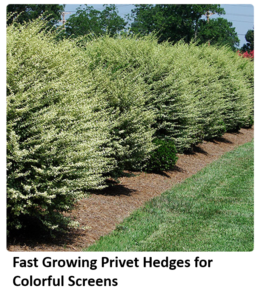 Ad for privet, one of the worst invasive shrubs.
Ad for privet, one of the worst invasive shrubs.So perhaps you can understand the many plantings of invasive plants in my yard over these early years including Bradford Pear, Privet, Vinca, Liriope, and Nandina. If you have an older house, you’ll probably have some of these plants in your own garden, along with other invasive plants like Oregon Grape, English Ivy, Sweet Autumn Clematis, and Wisteria. It is only in recent years that the story about these plants destroying native habitat has received much public attention. In fact, many are still available in nurseries, especially at the big box garden centers. It is an uphill battle to eliminate these invasives. The Bradford Pear and Privet are gone now from my yard, but some of the others remain. I just thank the gods that I didn’t plant English Ivy and Wisteria!
At some point in the 90’s, I started to get interested in using native plants for landscaping our yard. I had a print of Dot Wilbur’s painting titled “A Decade of Wildflowers, Celebrating Ten Years of North Carolina’s Wildflower of the Year,” which dates to 1993, hanging in my office for years. I brought the print home when I retired, and it still hangs in our house. This led to my first incursion into native wildflowers in a serious way, since I tried to grow all 10 of the ones she featured. I still have four of these growing in the yard, including Butterfly Weed, Coreopsis, Black-eyed Susan, and Wild Blue Indigo.
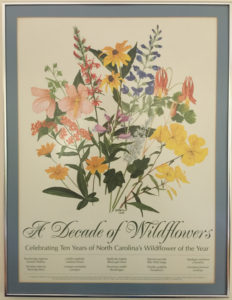 Dot Wilbur’s print hanging in my home
Dot Wilbur’s print hanging in my homeIt’s only in the last 12 years that I’ve become an avid birder and even more recently that I’ve totally connected the dots between my love for birds and love for gardening. Now I’ve also become familiar with the plight of our native pollinators. As part of the team that does Bird-Friendly Habitat Certifications for New Hope Audubon, I continue to learn about how everything is interconnected and the critical importance of restoring native habitat for birds, pollinators, and other wildlife.
Important to my education has been reading books like Doug Tallamy’s “Bringing Nature Back Home” and Rick Darke and Doug Tallamy’s “ The Living Landscape: Designing for Beauty and Biodiversity in the Home Garden.” I better appreciate now the interactions in the vertical layers of a native landscape from the canopy trees; to the understory trees and shrubs; to the herbaceous layer of wildflowers, grasses, ferns and ground covers; and even down to the leaf litter and decaying organic matter at the ground level.
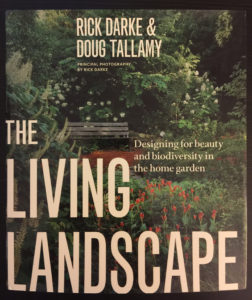
Also I’ve learned the importance of having plants that flower and set seeds or berries or act as insect hosts at different times of the growing season, so as time progresses through spring, summer, fall and into the winter, the food will be there to sustain wildlife. It is the presence of all of these layers interacting together in both space and time that support our birds, pollinators and other wildlife.
Over the past several years, I’ve been transforming my own yard into a more bird and pollinator-friendly habitat. It gives me great pleasure that my yard is certified now as bird-friendly. I’ve been adding to the native plants in each landscape layer and with regard to each season, and thanks to the sharp eyes and identification skills of the bird-friendly-habitat team, have been able to find and nurture native plants that already were there but were previously unknown to me. Remarkably, they were just growing there on their own, or wait, …isn’t that what native plants do?
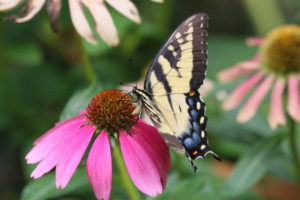 Tiger Swallowtail on Purple Coneflower, by Barbara Driscoll
Tiger Swallowtail on Purple Coneflower, by Barbara DriscollI’m also enjoying an updated version of the old tradition of “passalong plants,” where instead of sharing heirloom (and mostly non-native) plants, friends are now sharing native plants with each other. I urge you to do the same. I’ve also largely eliminated Japanese Stiltgrass and other invasive herbaceous plants, but, when I take a walk around the yard, I frequently still find and pull up sprigs of stiltgrass, English Ivy, and other invasives that are trying to get a foothold. It is a never-ending battle, but one well worth fighting.
If you’re just starting to become interested in restoring native habit for birds and pollinators by gardening with native plants and eliminating invasive plants, I hope my story will act as encouragement to continue “going native”. For those of you already well along the road, I’m sure you’ll recognize that there is always more to learn and, of course, always more work to do in the garden! Also if you, like me, feel powerless at times to affect the course of events in the wider world, remember that we can find solace in “tending our own garden.” Or more poetically written, “When the world wearies, and society ceases to satisfy, there is always the garden.” (by Minnie Aumonier)
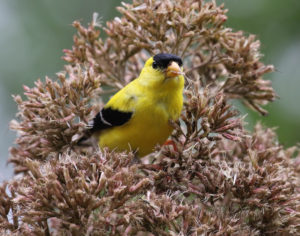 Goldfinch eating Joe Pye Weed seeds, by Barbara Driscoll.
Goldfinch eating Joe Pye Weed seeds, by Barbara Driscoll.Whether a beginner or expert, please avail yourself of the treasure trove of information and links on the New Hope Audubon web site at www.newhopeaudubon.org, which includes: what native plants to use and where to find them; what plants are invasive and how to get rid of them; what our certification program is all about and how to sign up; and other ways to make your habitat more bird friendly.
« Back to All Press